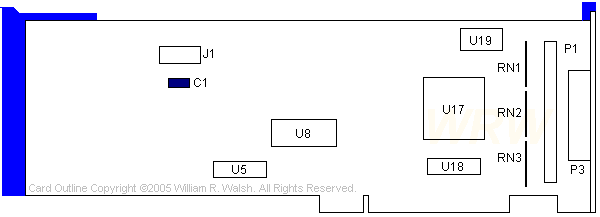Rancho Technology RT1000-MC SCSI Adapter - 708D
@708D.ADF
Louis Ohland found the option diskette via IBM-PC.org. (Please be aware that I have not done anything more than to give these files a quick once-over. Use them at your own risk!)
Rancho Technology was verifiably still in business as of 2013. By
mid/late 2014 they seem to have folded. The address once given for
their place of business looks to be a residence if Google Street View
is to be believed. Which kind of makes you wonder just how high the
barrier to entry for hardware design and manufacturing really is...
If you are looking for an adapter that can provide a drop-in hard
disk upgrade for a Model 70 or similar system where there are no
standard power connectors available without soldering or modification
then this is the one of a few adapters you can use. Use your best
judgment when putting drives in a system with a smaller power supply
(50, 50z, 55SX, 70). Also bear in mind that MCA bus connectors have
limits on how much power can be drawn over them.

U5 - Labeled "PAL047 Rev A"
U8 - RTBios version 8.20P
U17 - NCR 53C400
U18 - Labeled "PAL 045 Rev A"
U19 10.000000 MHz (how many zeroes worth of precision do we need?)
RN1, 2, 3 - Removable resistor packs for termination, no identifiable numbers or branding.
C1 - 22uF capacitor
J1 - 4 pin power
P1 - 50 pin internal SCSI
P3 - DB25 external SCSI port
Thoughts
I found this in a Model 70 paired with a Conner CP1080 hard disk. The
power cable has one connection at each end, but the SCSI cable has two
plugs on it. Both cables look like they came with the adapter (or most
likely a packaged upgrade kit including the adapter, since it has CMS
Enhancements stickers all over it). One thing I have noticed is the
vastly reduced heat output of this model 70...clear proof that newer
drives not only run faster but also run cooler. Performance-wise this
adapter seems a little slower than the uncached SCSI/A from IBM. It can
and does use the system hard disk LED (if you have one).
There is support for making a "floptical" drive appear as drive A. The ADF says this about the feature:
"If
you want your Floptical drive to be Drive A:, you Must choose the
option 'Drive A: is Floptical' and follow the instructions in the users
manual. Leave this option at 'Drive A: is NOT Floptical' if you have no
floptical drives attached or another drive is drive A:."
Linux Support
Saskia Bormann said this about the adapter and Linux:
I haven't tested yet, but your outline says that there's a 53C400
as controller. These are normally covered by the driver NCR5380 (watch
the nasty upper-case letters *grrr*), and you must provide the
following parameters to it:
ncr_53c400=1 ncr_irq=[IRQ] ncr_addr=[addr] ncr_dma=[DMA]
It _should_ work. Because that driver wouldn't probably find the
adapter on it's own, I'm writing a device manager that scans all slots
for the adapter IDs, and looks which modules with wich parameters are
needed.
Editor: I don't know whatever happened to any of this, or if the
adapter is in fact supported under Linux. Saskia seemed to wander off
not long after making this post. Modern Linux kernels have done the
unthinkable and dropped support for Microchannel hardware.
